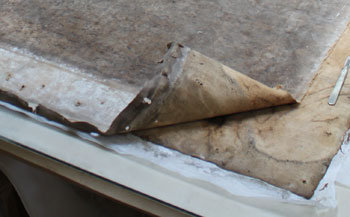Simon Blackwood Fine Arts
Restoring Oil Paintings
Restoration refers to the removal of surface dirt and discoloured varnish layers, the treatment of the support (canvas/wood/paper), the replacement of missing portions imitating the original by the sympathetic use of similar pigments, or building up fragments of sculpted or moulded areas of an artwork.
A good restorer will make sure that all techniques used in the restoration process are reversible and that any retouching is limited to the specific areas of paint loss or support damage.
To understand the processes involved in restoring an oil painting, it is necessary to know about the processes and materials used in making one.
The technique of oil painting
Oil painting, as we now know it, was fully developed by the 15th century, arguably defined by the work of Jan Van Eyck.
Oil painting offers many advantages to the artist. Strong depth of colour, luminosity and tone can be achieved and blending these colours and tones is easier than with tempera or fresco mediums. The painting can be built up in transparent or semi-transparent glazes, emulating some of the advantages of watercolour.
It can also be totally opaque, thus unwanted areas can be covered over easily or used as the base colour for subsequent glazes. After grinding, the pigment is bound with various types of oil (e.g. linseed/poppy) and can be diluted and thinned with spirits – usually turpentine.
The support
The types of support most commonly used for oil painting include wood panel, metal, paper, cardboard, composition board (similar to boards produced today by Daler and Windsor & Newton) and canvas. Each one offers different advantages for the artist and equally requires different procedures for the restorer. The principle is similar with most, to provide a stable support to which the suspended pigment will readily adhere. Wood panels coated in gesso were used earlier, with their smooth almost glass-like finish, possibly emulating the texture of fresco wall paintings.
Artists moving on to use canvas, partly because of its obvious size potential, initially tried to emulate this lack of texture with glues and gesso. The textural weave of canvas later became popular and was used to great advantage by artists such as Titian. Eventually gesso was replaced by lead white primers.
Disadvantages of oil painting
Whilst all these advantages and more offer huge scope for the artist to experiment they can leave a minefield for the restorer and in some cases have caused the rapid deterioration of the artist's work. For example, Joshua Reynolds had to repair some of his own paintings which were the results of such experiments.
The use of certain minerals and other experimental substances to create "effects" has also become renowned for obliterating whole areas of an image in a relatively short time – notably the use of bitumastic as a glaze during the 19th century which temporarily created an attractive "amber glow" but which later turned black and formed fissures and lumps like the surface of the moon.
Others like the pigment base "chrome yellow", used extensively by Vincent Van Gogh, discolour with age and others lose their "light fastness" or are considered "fugitive" – meaning that they fade and sometimes disappear completely. But on the whole oil paintings are more robust in this respect than water-based media.
Deciding what to do
Assessing damage
The results of good restoration often seem miraculous, especially as the owner of a painting may never have seen it in anything like its original state.
Even over a period of 25 to 50 years the accumulative effect of age and discolouration by air-borne and atmospheric agents is often imperceptible to the untrained eye. "Cleaning" is a process of carefully identifying the cause of any deterioration or discolouration and then removing or treating these layers, replacing missing pigments or structural supports and preserving the original (see "Does it need Restoring?"). The skill of the restorer is not only to understand the techniques and media used by the artist whilst having a breadth of experience in the use of solvents and chemicals of the trade, but also to nurture an appreciation of and ability to recognise what beauty lies beneath the veils of many years of neglect or adverse conditions. These "adverse conditions" can simply be the normal domestic conditions which most of us live in or places where works of art have been stored away for the future. Central heating, open fires, condensation, fluctuations in temperature, exposure to direct sunlight are examples of some of the conditions which can cumulatively create the need for restoration. The techniques used by different artists may themselves be the cause of deterioration as he or she experiments whilst trying to achieve the desired painterly effect. The job of the restorer is always to preserve and maintain the art object as close to the original state as possible for as long as possible with the aid of experience, skill and scientific knowledge.
Estimating the Cost
The major cost of any restoration work is time.
Simon Blackwood Fine Arts cannot offer "quotations" or fixed prices for specific Restoration works as the techniques used in painting vary considerably from one painting to another. This is true even in the case of different works by one artist.
Estimates by telephone cannot be given without our having seen or having first inspected the artwork. The exception is in the case of works on paper e.g. prints etc., where it is possible to give a general idea in relation to size and technique (if it is known).
Although estimates cannot be given without sight of the painting, a lot of issues can be clarified in a telephone call, or by a short visit at a convenient time. Call us on 01450 870870.
Please see our terms and conditions if you are unfamiliar with restoration processes.
Is it worth Restoring?
We are often asked this question. Our answer is: "Do you like the artwork enough to see it at its best, as near as possible to its original condition?"
Does it need Restoring? Should it be Restored?
"Every work of art starts out on the progressive path to destruction from the moment it is created. The artist can only hope to delay this time for as long as possible by the judicious choice of materials and their application with a sound technique. When the object passes from the artist's hands he can but pray it will be well looked after." Francis Kelly – 20th century restorer.
It is a matter of personal taste as to whether the ravages of time wrought upon an art object are acceptable or not. In the world of conservation choices are constantly being made and arguments rage regarding to what extent an object should be "restored". A missing arm from a sculpture, the face and eyes removed from an icon can be replaced by the artisan/restorer. But will something of its inherent history be lost in its restored appearance? A brand new stone urn bought at a garden centre can be painted with yoghurt and very quickly will take on the patina of age. Similarly "fakes" will be coated in all manner of substances. Painted images should be considered in the light of this. But there are effects of age or lack of care which can be reversed successfully to reveal something near the original state and reveal a beauty which was otherwise hidden.
Many owners of paintings brought to the restoration studio will never have seen them in anything close to the original state. Even if they have owned a painting for many years the changes which will inevitably have taken their toll on its condition will seem imperceptible. Surface dirt accumulates on paintings under normal conditions in exactly the same way and to the same extent as it does on curtains in the room or the walls the paintings hang on. If you move a painting from the wall and it leaves a pale rectangle where it was hung, that is a good measure of the amount of surface dirt it has attracted since it was last moved. If it leaves a darker, richer-coloured rectangle this is an indication of the potential effects which sunlight may have had.
Varnishes are also affected by atmospheric conditions, fluctuations in temperature, humidity and sunlight. Over many years the transparency of the varnish will become clouded and discoloured often resulting in a picture being viewed as if through an amber or even brown filter. "Bloom" may develop due to damp atmospheric conditions so that the transparency of the varnish and sometimes even the glazes in the pigment layers become "frosted" or milky. Oil paintings framed behind glass are often found to have "bloom" as the condensation on the inside of the glass reacts with the varnish film. All these circumstances will be recognised by an experienced restorer who will usually recommend "cleaning" or even varnish removal. The results often seem miraculous. Unfortunately, these effects on the varnish layers aren't the only results of the ageing process. Cracks which appear in the most extraordinary formations, apparently on the surface, are also caused by a number of complex interactions between the support (canvas, composition board, paper or wood), the primer and the pigment layers. Whilst the binding agent in the pigment (e.g. linseed oil) may have been used consistently throughout, the different minerals in the pigment itself will expand and contract under different tensions and over longer or shorter periods. These movements will create fissures, not only in the pigment and binder layers, but in the primer and varnish layers too. The worst results of this leave the painting attached to the support (canvas etc.) by luck or gravity rather than design. (See Structure of an oil painting and the re-lining process.)
Conservation and restoration
Conservation is the preservation, repair and prevention of deterioration of artifacts whereas restoration means to renovate and return an artifact to its original condition. In the sense that the term has been used here, restoration includes much of what is understood by conservation. Contemporary restorers often prefer to use the name conservation as it has a more curatorial interpretation. However, in museum conditions, Conservation includes the actions taken and studies made to revive damaged or deteriorating works of art and maintain them under correct, monitored conditions. Privately owned pictures or art objects, which will most likely be brought to a commercial conservation studio, rarely benefit from such care at any other time.

16th century oil on canvas after Masaccio - Christ's gift to St Francis – property of the Archdiocese of St Andrews & Edinburgh. Before and after cleaning. A test was first made on the pale skirt of the Bishop on the left.
Restoring Oil Paintings – background
The basic structure of an oil painting on canvas
1. The Stretcher is traditionally a wooden frame designed to expand by virtue of the corner joint design and the use of wedges which can be hammered in as the canvas stretches and warps over time.
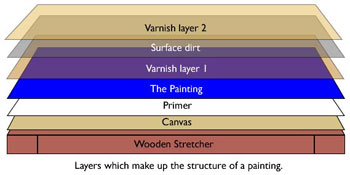
2. The Canvas is usually linen or flax (later cotton) which has been primed with glue (rabbit skin or later PVA etc.) which reduces its absorbency in preparation for the primer.
3. The Primer is the ground most suitable for the painting medium. Gesso was used extensively up until Victorian times having the advantage of being capable of filling the texture of the canvas for a smooth finish – lead white pigment was used later and can achieve a similar finish and is ideal for the reception of oil paint which binds well with it. More recently acrylic substitutes have been developed with the advantage of faster drying times.
4. The Painting medium and the method of application used by the artist will determine the longevity of the artwork. Most techniques involve layers of pigment thinned in a variety of ways to achieve the desired effect. Artists have always experimented and often use materials which deteriorate (like bitumen) or cause reactions with other chemicals.
5. Varnish can be used as a final coat which brings all the previous layers together tonally and as a protection, or as a way of separating some layers – known as retouching varnish. Turner often used a layer of varnish to allow the application of watercolour for fine details (rigging of ships) after which another layer would be applied, then more oil glazes before the final coat. Resin suspended in turpentine is the most common form although there are many variants. Often after the painting had reached a ripe age and accumulated surface dirt a way of "freshening up" the image would be to apply another similar varnish coat, thus most paintings of any age will have several layers of dirt trapped between varnish layers.
Re-lining an oil painting
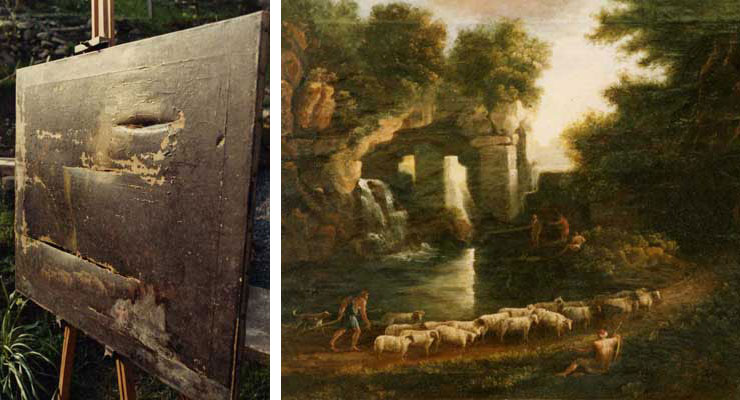
Alexander Naysmith oil on canvas left out for the bin men in Hawick in 1982.
The illustration above shows what can be achieved when an oil painting has been severely neglected. The canvas support had been torn in several places and around them large areas of primer and pigment were lost.
The first stage to save such a situation from continued deterioration is the application of a "facing" tissue which is applied to the surface of the painting to protect it and to temporarily hold any loose pigment areas or canvas tears in place.
The painting is then taken off its stretcher and laid down onto the lining table. A heat sensitive glue is pasted onto the old canvas from behind and a new canvas is bonded onto the old, suspended on its own stretcher or loom.
When heat is applied to the new canvas, the "glue" passes through the canvas layers into the primer and finally into the pigment layers securing the entire structure. Further consolidation of tears and areas of primer and paint loss is then administered from the front.
The materials used have been developed specifically for this purpose and are well tested for longevity.
Most oil paintings of any age have at some time been lined and as techniques have progressed old linings must sometimes be replaced with new.
Gallery examples
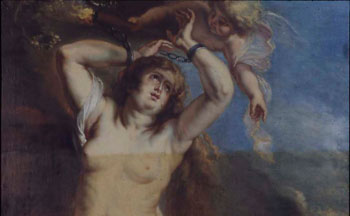
Beneath surface dirt and discoloured varnish, a sky in pigment made of Lapis Lasuli.
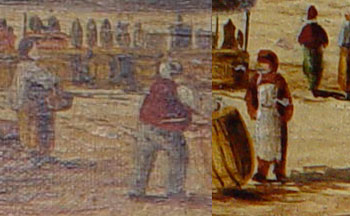
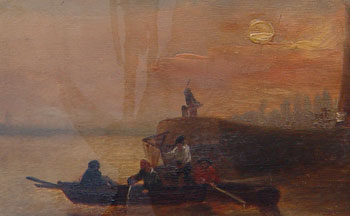
Surface dirt trapped between successive applications of varnish.
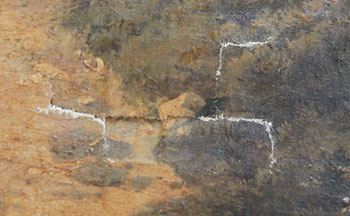
Tears in the canvas, excessive surface dirt and several layers of discoloured varnish
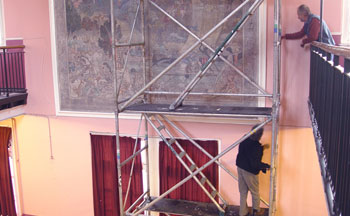
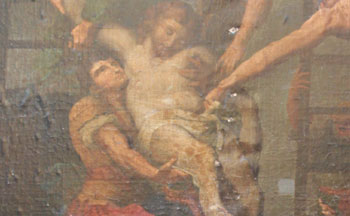
A badly damaged painting. A step by step record of a big project.
